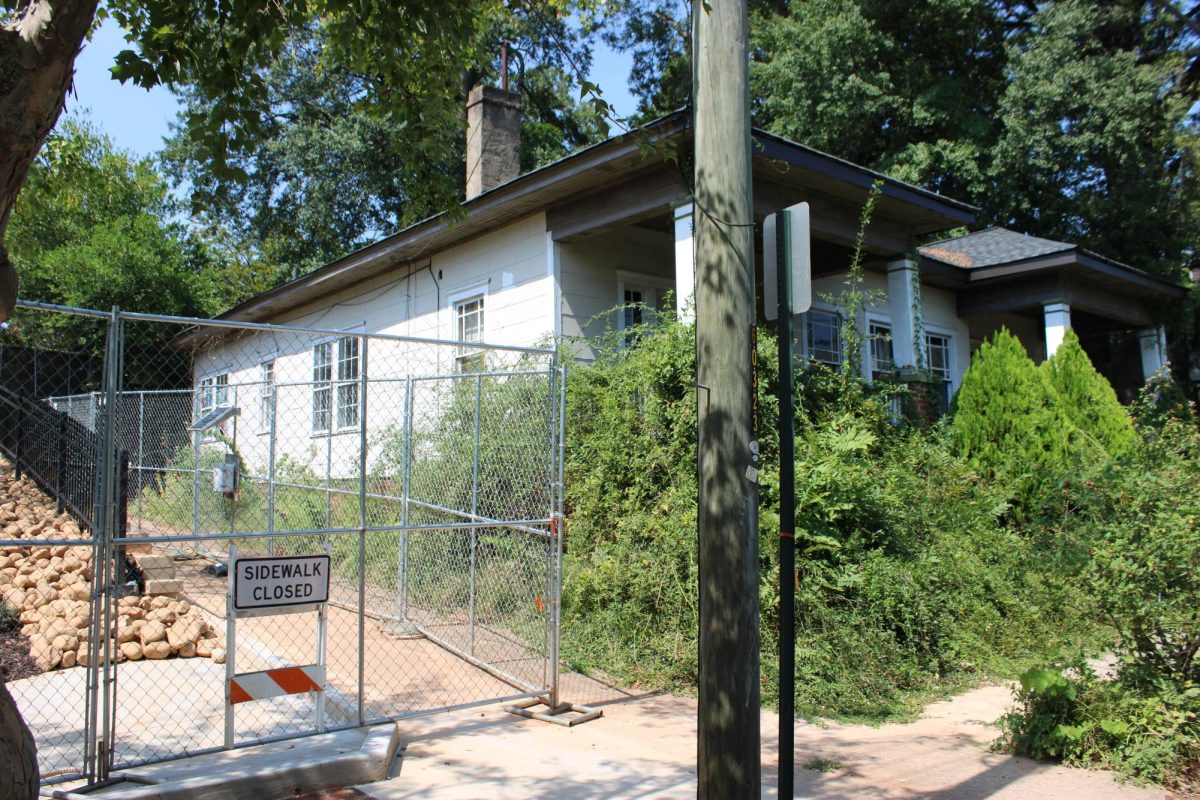During a Nov. 12 local school council meeting, administrators and parents decided to petition APS for the construction of a bus lane on Eighth Street. Currently, the outside lane the buses use to drop off and pick up students is not an official bus lane, and thus is illegal for Grady buses to use, according to Assistant Principal David Propst. Propst was unsure when the lane will be constructed and how long it will take to be constructed, saying it could range from weeks to months. He said that during the construction of the bus lane, the administration may move the buses from Eighth Street to the 10th Street student parking lot, but that the plan is still up in the air.
In a meeting with parents, administrators, police officers and students on Oct. 30, Propst discussed the possibility of rerouting Grady’s buses so that they drop off students in the 10th Street student parking lot in the morning, as opposed to the current Eighth Street location. Officer Antwan Denson, who proposed the plan, said his ideas will ease traffic and make student transportation safer. A safety study conducted by an urban planner from the City of Atlanta also confirms the logistics of Denson’s plans and proposes more developments for improving transportation safety in the area.
Denson came up with the idea after the school started receiving complaints about the traffic situation on Eighth Street from parents and other members of the community. The problem arises from the fact that people use Eighth Street as a way to avoid the traffic on Tenth Street in the morning, which, in turn, creates traffic jams on Monroe, stretching all the way to Piedmont Avenue. Propst, Denson and many parents agree that there are too many sources of traffic on Eighth Street. These include buses, parents dropping off their children and students crossing the street.
“It is a real problem on Eighth Street, so it is worth trying something different and even if it doesn’t work perfectly, it might work better,” parent Lynette Slovensky said. “It’s the first year we’ve had someone come in and really take ownership like Officer Denson has done, which is really impressive to me.”
Denson thinks the plan will likely work because currently the buses arrive at staggered times throughout the morning, and most arrive before students who drive themselves. He said ideally there should never be more than two or three buses in the parking lot at one time and that there will be police officers stationed in the parking lot and on 10th Street every morning to make traffic move more smoothly. He also said the five PEC buses will continue to drop off students at the Eighth Street entrance at a later time so those students are able to enter the school easily.
The new plan requires parents to drop off their kids at the Eighth Street entrance, rather than the student parking lot. These students will then walk around the school or through the driveway behind the musical hall to enter the school through the cafeteria doors by the courtyard. Denson and Propst think that having everyone enter in one place, but with the same number of metal detectors, will maintain efficiency while improving safety.
Some parents, however, are not so supportive of the proposal.
“I think that [the 10th Street] parking was not designed for buses and that it creates a problem for student drivers,” Sharon Bray said. “I think also that we have enough problems with Tenth Street and the new bike lane and all the issues there, and that adding buses to the mix just makes that street more dangerous.”
Parent Shannon Kishbaugh agrees the idea will probably make the traffic on Eighth and 10th Streets worse.
“I personally feel since it’s the student parking lot, the only people that should be allowed there are the students that drive,” senior Troy Hightower said. “I think that the parents should drop their kids off on Charles Allen, the buses [drop kids off on] Eighth Street and we keep the student parking lot for students. It causes a lot of traffic in the morning.”
Another part of the proposal is to mandate that bikers turn on Eighth Street and into the parking lot area by the music hall and football field to park their bikes. The reason behind this proposed change is to reduce both the risk of bike accidents in the student parking lot as well as the risk of turning left on 10th Street from the bike lane into the parking lot.
Sophomore Nicholas Lyman, who bikes to school every morning, feels that the plan is advantageous for those, like himself, who come from the BeltLine, and that with less traffic on Eighth Street, the plan could work for all bikers. He was, however, skeptical of the plan of moving the buses, saying he doesn’t think it will work as a whole.
The local school council members, parents, stakeholders and the Grady administration also sought the advice of Joshuah Mello, the assistant director of planning for the City of Atlanta Department of Planning and Community Development Transportation Division. Mello, along with other members of his department proposed a comprehensive plan under the Safe Routes to School initiative.
“Safe Routes to School programs connect transportation options with public health needs with the quality of our environment with the livability of our communities,” Mello said in his Nov. 4 report.
The report titled Henry W. Grady High School Safe Routes to School Study – Final Report details a plan to install secured bicycle cages in the northwest corner of the school building by the Charles Allen side, where student cyclists would park their bikes after crossing the street at Charles Allen Drive.
The report, among other things, proposes creating a safer pedestrian crosswalk through the construction of curb extensions at the intersection of Eighth Street at Charles Allen Drive and Ninth Street at Charles Allen Drive and upgrading and relocating traffic signs and pedestrian buttons.
The safety committee also discussed a TED Analysis of the campus grounds. The analysis consisted of Propst and two police officers walking around the campus while identifying any and all safety hazards with landscaping, lighting, fencing, etc. Bray said they rated almost every category of criteria poor or inadequate, with issues such as more than 40 outside lights not working, overgrown shrubbery impeding visibility and unlocked gates and unsafe access onto the grounds.
Kishbaugh said the lighting at Grady is so bad that she fell down the steps leaving Grady one night. Propst and Denson both said they are planning to replace all of the lights with LED lights that will last much longer.
“I think the TED analysis is good evidence that change needs to happen,” Bray said.
The local school council, with the help of Propst and Denson, will draft a letter to the APS Facilities Services Department presenting the issues of safety brought up by the TED Analysis and requesting the financial assistance to address them.
“I hope that APS will be responsive with providing the funds to improve the lighting and improve the landscaping issues they were looking at,” Slovensky said.
Other improvements the safety council has made include new “go packs” for every teacher so that they have the supplies they need on-hand in the event of an emergency. The packs contain basic emergency necessities such as First-Aid kits, flashlights, and safety vests for teachers. All of the administrators have industrial-grade “go packs”, containing medical supplies in the event of a serious injury.
Additionally, the administration will begin requiring that all vehicles parking in the student lot be registered and given a Grady decal.
In the Oct. 30 safety meeting, Denson said Grady has a mentality that is resistant to change. Despite protests to the proposal from some parents and students, one thing that Propst said is universally agreed upon: any proposal that puts children out of harm’s way is a good proposal.






